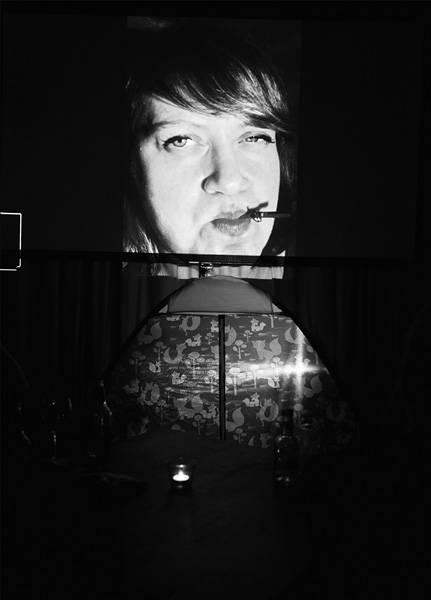
IRRETRIEVABLE BREAKDOWN
first performed on February 4, 2016
Toynbee Studios, London, England
performed twice in 2016
ANYA LIFTIG
Milford, CT
976504378a976504378l976504378i976504378f976504378t976504378i976504378g976504378@976504378g976504378m976504378a976504378i976504378l976504378.976504378c976504378o976504378m
anyaliftig.com
IRRETRIEVABLE BREAKDOWN
ANYA LIFTIG
Addressing modern urban loneliness and the breakdown of a relationship, “Irretrievable Breakdown” tells the tale of a desperate winter in Brooklyn, NY. The work is transmitted from the interior of a children’s play tent. Once the story is told an image appears in the space. A silent face ballet is performed live using miniature talismans broadcast from inside the illuminated structure.
From the text:
Each week, on the eve of trash day, scavengers would rifle through the neighborhood garbage nabbing a slightly scuffed Eames lounger here, a crooked Knoll bookcase there. In fact, it turned out that there was a whole black market economy funded by our trash. Leave something out on the street and the next day, it would be on Craigslist, spruced up with a slap of paint and new knobs. There also appeared to be a neighborhood syndicate solely devoted to rummaging for cans and plastic bottles that could be returned for deposit. The tiny, wiry Chinese women were the most aggressive. They would shove you out of the way in front of your own can. And why not? Here were thousands of people who were so rich that they literally threw money out in the trash. It would have been criminal not to capitalize on the distinctly American combination of waste and laziness. I could hear them fighting for turf on recycling day and I got used to seeing my trash busted open on the sidewalk, bloody tampons and all. Rather than donate unwanted books to the library, people placed them on their stoops, a sort of faceless high-brow swap meet: years’ worth of Paris Reviews, decades of Private Eye. There were pickers whose only job was to round up these books and sell them back to the same people who tossed them. It was not unlike living under a swarm of quietly hovering buzzards.
But even this oddball ecosystem was strangely beautiful and if there was ever any question about its merits, it was ugly in only the most beautiful, most significant way: five-dollar cups of licorice-noted pour-over coffee, ice cream made from the milk of cows rocked to sleep every night with Ukrainian folk songs, letterpressed note cards embossed with the ink of blueberries picked by workers paid a living wage, pimento loaf imported from the most ass-backward county in Alabama. Everything was sourced, curated, and sustainable, each moment a precious opportunity to be more authentic.